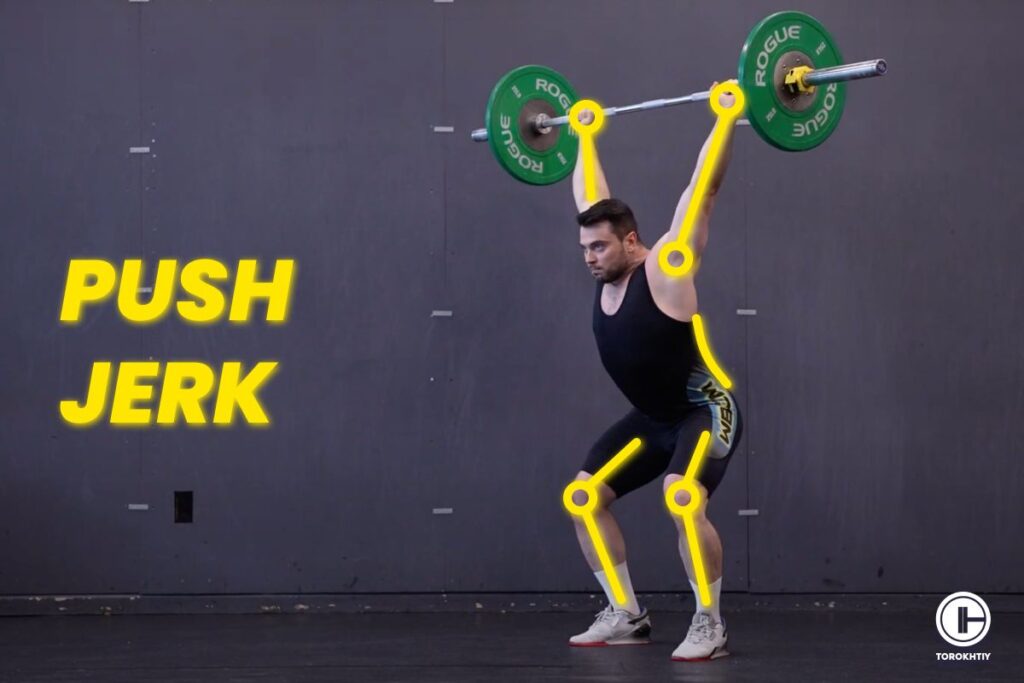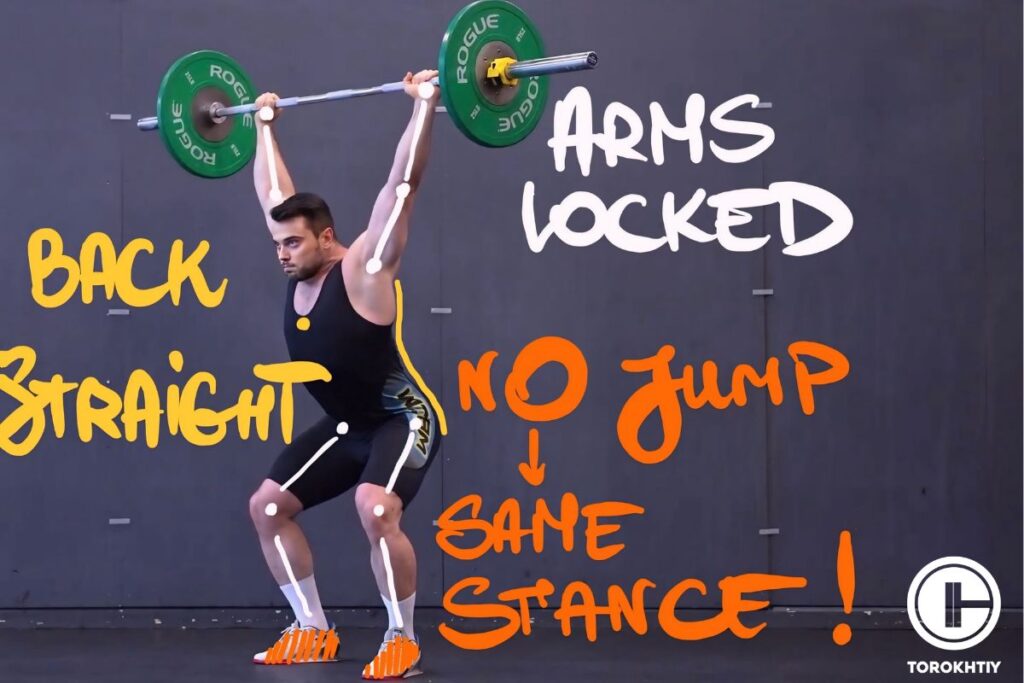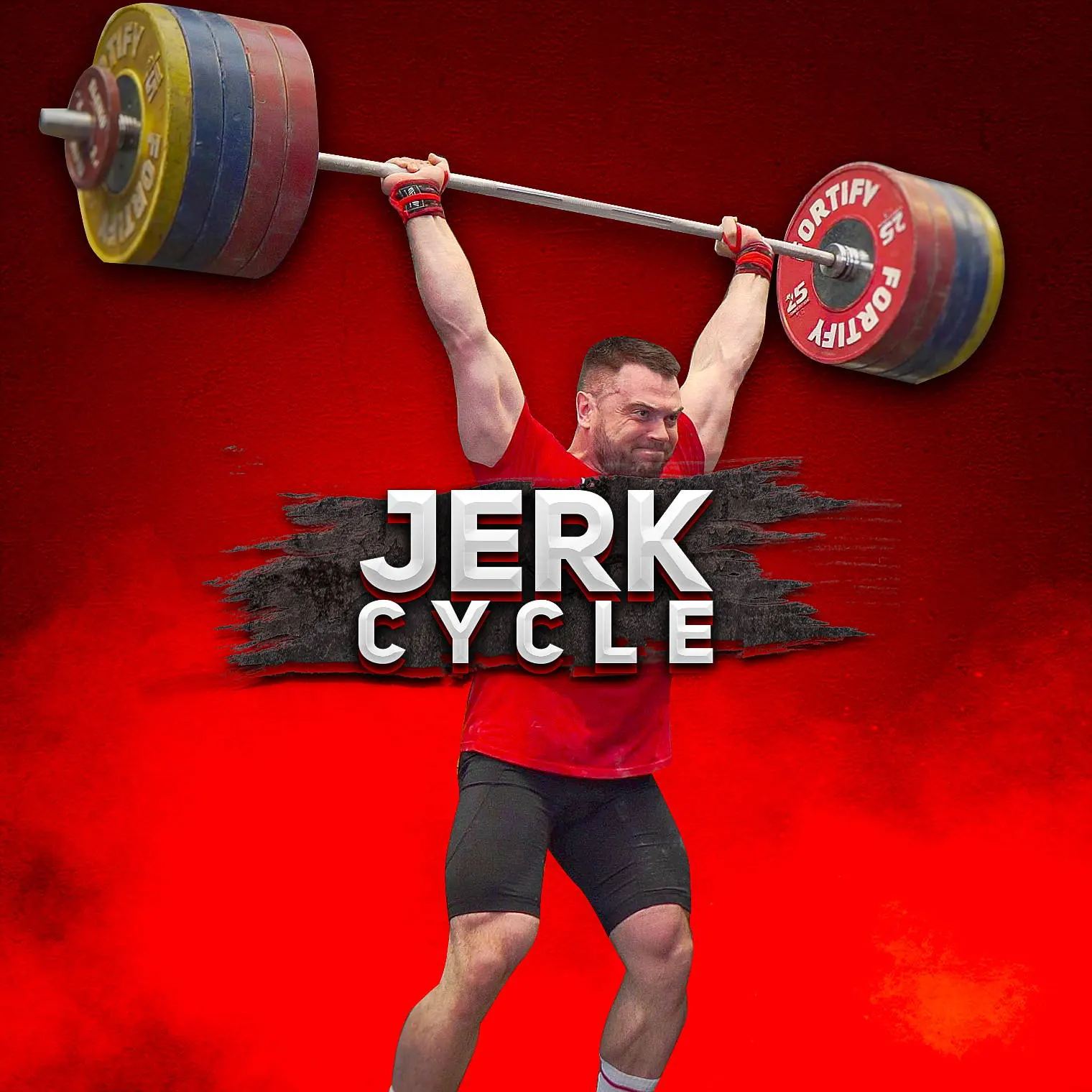Push Jerk: Technique, Benefits & Common Mistakes
Author:
Unlock your full potential by engaging with our experts and community! Have questions about your fitness journey or looking for expert advice on weightlifting techniques? Don’t hesitate — leave a comment below and Oleksiy Torokhtiy will provide a personalized answer and insights to help you reach your goals.
Torokhtiy is reader-supported. Some links are affiliate links, and we may earn a commission at no extra cost to you. See our disclosure page for details.
If your movements are lacking that explosive oomph, you might want to think about including the push jerk into your routine. It builds strength, improves coordination, and enhances athletic performance. It’s a workout that targets your core, legs, and shoulders and gives a real boost to your power and stability overall.
Sounds great, right? We’re just getting started, though, and we have a lot more to share; we’ll tell you how to do it, explore the benefits and common mistakes, and even go through a few exercises that are kind of like the push jerk, but different. Just to keep things fresh.
Let’s start right away; there’s a lot to cover!

What Is the Push Jerk?
The push jerk is a powerful exercise where you lift a barbell from your shoulders to overhead and you use a combination of leg drive and upper body strength to do it. If you’ve ever tried the push press or split jerk, you’ll be able to do the push jerk because your muscles will have to do the same amount of work.
You start with a dip; bend your knees a little, lower your body, and then follow with an explosive drive up and use momentum to get the barbell overhead. The exercise finishes with a quick drop under the bar to fully extend your arms and lock out the weight.
Why should you do the push jerk? Well, it will do wonders for your explosive power and strength, especially in the legs, core, and shoulders. It’s a staple for many people.
How to Do the Push Jerk?
Time for the fun part! Let’s see how to do the push jerk exercise.
1. Setup
Stand with your feet shoulder-width apart and place the barbell on your shoulders, with a grip slightly wider than shoulder-width. Your elbows should be pointing forward a little.
Before you start the lift, engage your core to stabilize your torso, and keep your chest up and back straight. Look straight ahead.

2. Dip
Bend your hips and knees a little and lower yourself into a quarter squat. This dip should be slow and controlled, and it shouldn’t be an actual, deep squat. Make sure to keep your torso up and don’t lean forward because that will throw off your balance and make the lift less effective.

3. Drive
Extend your hips and knees explosively to generate upward momentum. Push through your whole feet and extend your legs. You need this powerful leg drive to propel the bar up. The more force you generate from your legs, the easier it will be to lift the bar overhead.

4. Push and Drop
As the barbell continues moving to the highest point, quickly drop your body again; bend your hips and knees and get under the bar. Keep “punching” the bar up to Catch it with your arms fully extended overhead, using the momentum from the drive.
Difference between push jerk and power jerk is small but in the push jerk you don’t jump into a different stance. During the drive you go on your toes and then drop into a squat without moving your feet.
5. Catch Lock Out
Once the barbell is overhead, be sure your elbows are locked. Your head should be slightly forward with the biceps close to the ears. Your body should form a straight line from head to heels.
6. Stand Up
Straighten your legs and return to a fully upright position. Keep the barbell overhead with arms locked out. Your core should stay engaged and your back should be straight to support the weight and prevent it from wobbling. This is the final position and if you’ve managed to get here – good job!
Now all that’s left to do is to carefully lower the barbell back to the starting position and repeat!
Save it for easy access!
Bookmark this page now to access the program and instructional videos anytime, anywhere.
Stop wasting time searching during your gym sessions.
How to Program Push Jerk?
| Level | Reps | Sets | Frequency |
|---|---|---|---|
| Beginner | 5 | 3 | 2 times a week |
| Intermediate | 3-5 | 3-5 | 1-2 times a week |
| Advanced | 1-3 | 3-5 | Combine it with front squats or cleans to add some fatigue and mimic the competition lift. |
Beginner
- Start with 3 sets of up to 5 reps per set to make sure you don’t lose accuracy
- Do the push jerk 2 times a week
- Use either an empty barbell or super light weights because your priority is mastering the form. Once you’re able to do the exercise with perfect form, you can increase the weight by 5 to 10 pounds
Intermediate
- Do 3-5 sets of 3-5 reps per set
- Do the push jerk 1-2 times a week
- Keep increasing the weight in 5 to 10-pound increments to allow for progressive overload. The weight should be challenging, but manageable and it should not mess with your form.
Advanced
- Do 3-5 sets of 1-3 reps per set
- Do the push jerk workout with different weights to focus on qualities that require your attention – speed, power, strength. Combine it with front squats or cleans to add some fatigue and mimic the competition lift.
- Focus on fine-tuning your technique and increasing maximum lift capacity. Include Push Jerk into your Oly lifting complexes to solidify the movement pattern.
Follow us!

Free!
Get a 2-week Weightlifting Program as a bonus for the subscription to kickstart your training plan!

Free!
3 Common Push Jerk Mistakes
❌ Uncontrolled Dip
The dip is crucial. If it’s too shallow, you won’t generate enough power, and if it’s wobbly, you’ll lose control. If it’s too deep you may not generate enough acceleration or just get fatigued. Aim for controlled quarter squat.
❌ Lack of shoulder stability
It is not only about locking your elbows. Lack of shoulder stability, correct shoulder rotation and shoulder blade position won’t allow you to stand up in a controlled manner and you will lose the lift.
Shoulder blades should be retracted but the shoulder rotation is a topic for a full article as it depends on many factors. Make sure you stabilize the whole system instead of just locking your elbows.
❌ Weak Core Engagement
Your core needs to be rock solid the entire time. If it’s loose, your form will suffer, and we all know that proper form is what makes the exercise effective and it prevents injuries. Tighten those abs to keep everything in line.
3 Benefits of Push Jerk
✅ Better Performance
This is an excellent exercise for anyone that wants to improve their performance. If you’re a lifter, it will teach you better body coordination and timing, and if you’re an athlete, it will improve your performance because you’ll be able to generate power faster than before.
✅ Core Strength Full-Body Strength
The barbell push jerk is fantastic for building core strength. When you do it, your core muscles have to work overtime to stabilize your body and the bar overhead. Also, the exercise needs a lot of movement while the core should stay stable and not flex or extend your spine, so it’s an excellent workout for it.
Tips From the Champ
In my experience, the push jerk is a game-changer for getting heavy weights in split jerk as well. Push jerk gives best feedback about the dip and drive phase quality. If you lose an upright core position, will drop your body in the dip too fast or drive the bar forward – push jerk catch position will be uncomfortable or weak.
Olympic Weightlifting Champion
✅ Power Development
The explosive nature of the power jerk workout will make it easier for you to generate power. This is especially good for athletes.
Push Jerk Variation
Pause Push Jerk
Add a pause at the bottom of the dip before driving up. This increases TUT and forces you to maintain control and stability. What it also does is it may help with aggressive drive but it can be an excellent tool to help you with training and solidifying correct dip depth and position.
2 Push Jerk Alternatives
1. Dumbbell Push Jerk
Instead of a barbell, you’ll use dumbbells and work each arm independently. This can help you increase your range of motion and it can address muscle imbalances.
2. Push Press
This is a simpler version of the push jerk where you use leg drive to help press the bar overhead, but there’s no drop after drive . It focuses more on the strength of your shoulders and triceps.
Who Should Do the Push Jerk?
1. Athletes
Athletes will love the push jerk because it will improve their explosive power, coordination, and strength, which translates to better performance. It won’t do that much for your jumping power, though, so you’ll need to find another exercise to work on if you want to find something very specific. It will do a general job well.
2. Olympic Weightlifters
The push jerk is a staple for Olympic weightlifters because it directly contributes to the clean and jerk.
3. Fitness Enthusiasts
The push jerk is a compound movement, so if you’re looking to build strength and power, this will do that for you. Plus, it will add variety to your training.
Muscles Worked by the Push Jerk
The push jerk targets many of your muscles. Mainly, it address your legs and hips power but also improves stability of your shoulders. Your legs get a solid workout during the dip and drive, and your core is engaged the entire time to keep you balanced and stable.
Basically, it will build both upper and lower body strength, and it will also boost your power and coordination.
Conclusion
That’s a wrap on the push jerk! We’ve gone over everything, from what it is and how to do it to the push jerk muscles worked. There’s hardly anyone that wouldn’t benefit from it, so what are you waiting for? Grab a bar and get right to it! You’ll thank us later.
Actually, before you start working out, take a few moments and let su know what you think. Have you tried the push jerk before? Any variations you’ve experimented with? What results have you seen from it?
Drip your thoughts and questions in the comment section!
Also Read:
- CLEAN & JERK
- Power Jerk
- Split Jerk
- My Top 3 Exercises for the Split Jerk Stability
- Top 3 Exercises for Jerk Dip & Drive
- Snatch vs Clean & Jerk
References:
- Daniel J. Cleather, Jon E. Goodwin, Anthony M. J. Bull, “Intersegmental Moment Analysis Characterizes the Partial Correspondence of Jumping and Jerking,” Journal of Strength and Conditioning Research 27, no. 1 (2013): 89-100.
- Daniel Plotkin, Max Coleman, Derrick Van Every, Jaime Maldonado, Douglas Oberlin, Michael Israetel, Jared Feather, Andrew Alto, Andrew D. Vigotsky, Brad J. Schoenfeld, “Progressive Overload Without Progressing Load? The Effects of Load or Repetition Progression on Muscular Adaptations,” PeerJ 10 (2022): e14142.
- Kinetic Select, “Push Jerk,” Exercise Technique Manual for Resistance Training, Third Edition, October 2018.
- Marcos A. Soriano, Jason Lake, Paul Comfort, Timothy J. Suchomel, John J. McMahon, Ester Jiménez-Ormeño, Pilar Sainz de Baranda, “No Differences in Weightlifting Overhead Pressing Exercises Kinetics,” Sports Biomechanics, October 27, 2021: 1-13.
- Marcos A. Soriano, Timothy J. Suchomel, Paul Comfort, “Weightlifting Overhead Pressing Derivatives: A Review of the Literature,” Sports Medicine 49, no. 6 (2019): 867-885.
- Photos by Torokhtiy Media Team.
Why Trust Us?
With over 20 years in Olympic weightlifting, strength training, nutrition coaching, and general fitness our team does its best to provide the audience with ultimate support and meet the needs and requirements of advanced athletes and professional lifters, as well as people who strive to open new opportunities and develop their physical capabilities with us.
By trusting the recommendations of our certified experts in coaching, nutrition, and sports training programming, as well as scientific consultants, and physiotherapists, we provide you with thorough, well-considered, and scientifically proven content. All the information given in the articles concerning workout programming, separate exercises, and athletic performance, in general, is based on verified data.
The product testing process is described in more detail here.
Author: Oleksiy Torokhtiy
Olympic Weightlifting Champion
Best Results: Snatch – 200 kg,
C&J – 240 kg
Oleksiy Torokhtiy is a professional athlete boasting 20 years of experience in Olympic weightlifting. With multiple European and World titles under his belt, he has showcased his prowess in two Olympic Games (Beijing 2008 and London 2012). Upon concluding his illustrious career, Oleksiy dedicated himself to coaching. By 2022, he had conducted over 200 weightlifting seminars worldwide. He is the visionary behind an international sportswear and accessories brand known for its motto, “Warm Body Cold Mind.” Additionally, he is an esteemed author and the creator of a series of training programs and eBooks.





Still have questions after reading our article? Unlock your full potential by engaging with our experts and community! Don’t hesitate — leave a comment below and Oleksiy Torokhtiy will provide a personalized answer and insights to help you reach your goals.